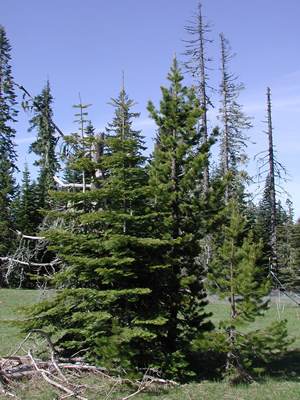|
Tree
encroachment into systems long dominated by herbaceous plants implies
a shift in the factors that once limited tree establishment. These
factors are typically assumed to be extrinsic, or external, such
as changes in climate or disturbance regime (fire or grazing). However,
limited attention has been paid to intrinsic factors—including
biotic interactions or positive feedbacks—that can maintain
or accelerate tree invasions once they have begun.
Objectives. We
focused on recent invasions (mid- to late-1900s) at Bunchgrass Ridge—a
period for which trees can be precisely aged, losses to mortality
are small, climate records are complete, and cone-production data
are available. Our objectives were three-fold:
-
to assess the contributions of climate variation, seed availability,
and biotic interactions (inferred from spatial associations)
to establishment of lodgepole pine (Pinus contorta)
and grand fir (Abies grandis)
-
to quantify the nature and strength of interactions among trees
and how these change during the invasion process
-
to illustrate how multiple sources of evidence—including
population age structures, climate and cone production data,
species’ life histories, and spatial associations—can
provide insight into the dynamics of tree invasions
Methods
In
a 0.21 ha (30 x 70 m) plot supporting recent establishment, we mapped
and aged 929 trees >0.3 m tall.
For
the primary species, grand fir and lodgepole pine, we correlated
age structures with climate records (precipitation, temperature,
and snowpack) and regional data on cone production (available for
grand fir only).
We
inferred the importance of biotic interactions from spatial associations
among trees and how these changed over time. We used a combination
of methods to explore spatial patterns at increasingly finer temporal
resolution: inhomogeneous variants of the Ripley's K and
pair-correlation functions (for both uni- and bivariate tests),
the J-function, and a novel evolving nearest-neighbor metric.
| Rice,
J. M., C. B. Halpern, J. A. Antos, and J. A. Jones. 2012.
Spatio-temporal patterns of tree establishment are indicative
of biotic interactions during early invasion of a montane
meadow. Plant Ecology 213:555-568. Request reprint |
|
| Recent
conifer invasion |
Lodgepole
pine
invading meadow |
_13%20Ju%202009_sm.jpg) |
Lodgepole
pine
facilitating grand fir |
 |
|
|
![]()
![]()
![]()
![]()

_13%20Ju%202009_sm.jpg)
